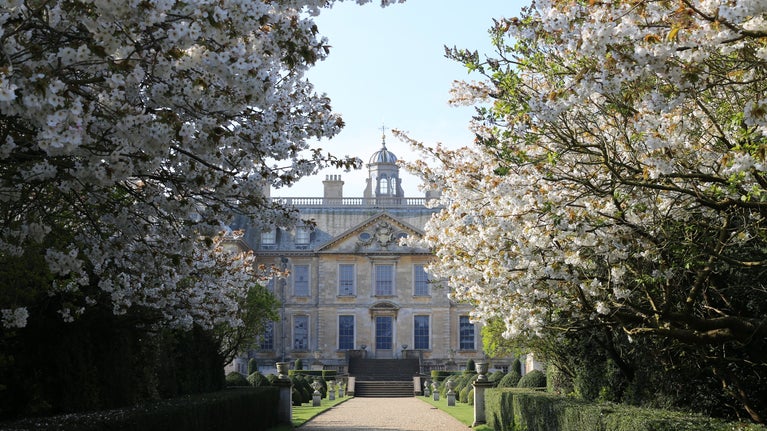
Discover more at Belton
Find out everything you need to know about visiting Belton, including how to get here, things to see and do on your visit, and more.

With 1,300 acres of parkland surrounding Belton House, there's plenty to explore beyond the garden, including wildlife-rich open grassland, the River Witham and ancient woodland. The deer can be easily seen on walks across the parkland, with plenty of opportunity for some great photos.
Discover the resident Woodpeckers that call Belton home on our Woodpecker trail through the parkland. Enjoy a wander through the parkland on this trail and see if you can see or hear our feathered friends, while learning more about them.
Belton bathed in cloudless skies and warm sunshine is glorious, and it’s not only our human visitors who enjoy the added warmth and longer daylight hours. The summer heralds plenty of new arrivals around the park, whether they’re newborn or fully-fledged.
With the previous autumn’s rut nothing but a dim and distant memory, the deer herd have overwintered as best they can. The warmer weather and all the new growth that it brings means the bucks will be eating their fill – recovering lost condition, casting their antlers, and putting on as much weight as they possibly can.

Fawns are generally born in June and early July. The female does take themselves away from the herd. They seek out a secluded spot with rough grass or nettles for protection and give birth to a single fawn. After 20 minutes or so the fawn will be up and about and the doe will return to the herd with her fawn beside her.
Fallow deer can be seen across the park throughout the year, but during the fawning season, you’re more likely to see them at a distance in woodland areas. During this time, it’s important to take care not to disturb them.
It is vital that the fawns are left undisturbed by humans or dogs at this time of year. They haven’t been abandoned, far from it – they’re just waiting for mum to come back from feeding. Once the fawns are strong enough, they’ll run with the rest of the does and fawns in the herd and be fully weaned by the time the rut comes around again in October.
When these chatterboxes perform their aerial acrobatics over Belton’s Oval again, you know that summer has well and truly arrived.
Sometimes easily confused, the swallows have white bibs, red chins, and long streamers to their tails; the swifts are a dark-blue all over (even underneath) and make a distinctive screaming noise as they wheel overhead, and the house martins have white bibs but a much less showy v-shaped tail.
The birds you see at Belton arrive in the UK from Southern Africa; they fly vast distances of up to 200 miles a day in a migration route that takes them all the way across the Sahara.

Belton's butterflies and the wildflowers come hand-in-hand. Good early nectar sources, such as hawthorn trees and hedges, play an essential part in supporting the butterfly and moth populations, as do the wildflowers and flowering grasses found across the parkland. Look out for whites, orange tips, common and holly blues, peacocks, small tortoiseshells, and speckled woods, to name but a few.
Look out for the ewes and lambs in the park. These animals play such an important part in helping to manage Belton’s grassland habitats sustainably.
Without livestock, the ranger team would be battling rank grasses and mountainous spoil heaps from the healthy population of meadow ants (great for the green woodpeckers!). But with their help and in partnership with local graziers, Belton’s rangers can keep the parkland healthy and in balance without the need for any drastic intervention. The livestock look pretty happy for it too.

Find out everything you need to know about visiting Belton, including how to get here, things to see and do on your visit, and more.

Belton is a three pawprint rated place and offers plenty of opportunities for bounding, jumping and sniffing for dogs. With 1,300 acres to explore, come and join us for a wander with your four-legged friend.

Explore the gardens at Belton, including the Italian Garden, a Conservatory and a Dutch Garden with formal bedding schemes. Whatever time of year you visit, the shifting seasons provide a great variety of colour and wildlife to see.

Packed full of treasures, discover a mansion bursting with history. Belton's collection tells a story rich in global history and our future work will focus on bringing those stories to life.

Explore our fun family day out ideas, including our indoor play area and outdoor adventure playground. Make the most of your day out with the kids at Belton and plan ahead for Summer of Play.

The Belton Estate played a significant supporting role in the First World War. Find out about the small town, with hospital and cinema, built for 20,000 men of Kitchener’s Army.

Explore some of the finest landscapes in our care on coastal paths, accessible trails, woodland walks and everything in between. Find the best places to walk near you.

Plan a visit to one of the special countryside places in our care and discover the benefits of being in the great outdoors. Pack your walking boots and get ready to explore woodlands, valleys and rivers.